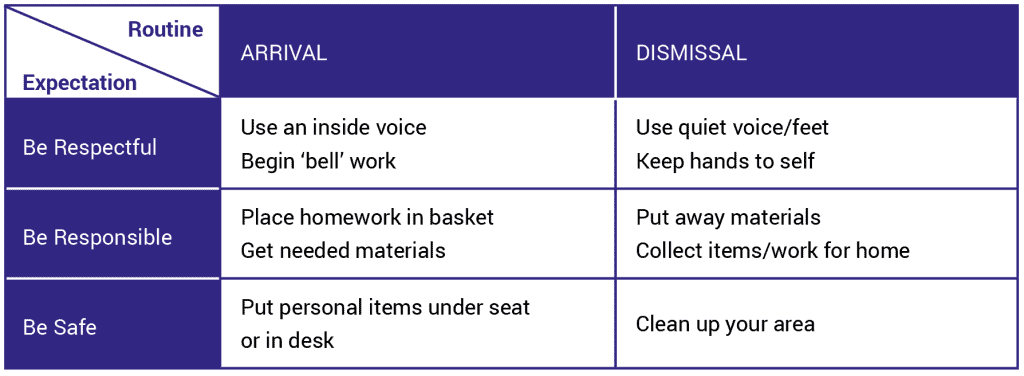In order for students and teachers to achieve maximum benefit from the learning experience, it is critical to create a positive and productive educational environment. Teachers can prevent many occurrences of problem behaviour and minimise disruptions by strategically arranging the physical environment1 and establishing clear and consistently used routines2. The purpose of this guide is to describe an evidence-based classroom practice, maximising structure, that is part of an effective classroom management system to promote learning.
What does it mean to maximise structure?
Maximising structure in the classroom includes designing effective, safe, and supportive classroom environments to promote a positive teaching and learning experience for all students and teachers. Establishing classroom routines and procedures to increase predictability for students and arranging the classroom to prevent challenges are discussed below.
Effectively designing and arranging the physical environment: this involves arranging the classroom environment so all students can see, hear, and easily move in order to maximise learning3. It requires organising furniture to facilitate movement, allowing smooth traffic flow and easy access to materials and personal items. There are designated areas for specific activities (such as small group vs. independent work) or specific users (teacher/adults vs. students). The age, developmental needs of the students and content taught will determine how the classroom is arranged (for example, younger students may have tables for activity centres while secondary students may need circles for group discussion). A well-designed classroom provides clear visibility throughout the room and reflects the diverse cultural and linguistic characteristics of the students.
Engaging in active supervision and proximity: this is a proactive, preventative strategy used to monitor all activity throughout the room and provide additional structure for the students4. Teachers who engage in active supervision continually scan and move about the room, providing students with a sense of safety and regular opportunities to build teacher-student relationships. They continuously roam throughout the room, positively interacting with their students, and are rarely seen at their desks. Designing and arranging a physical environment with a smooth traffic flow makes it easier to engage in active supervision and maintain close proximity with students during learning.
Developing predictable classroom routines or procedures: this provides students with clear, concrete behavioural guidelines about what is expected of them throughout the day. The specific steps of each routine should be clearly outlined and posted so students are able to complete the routine or procedure independently5. Routines occurring on a regular basis such as arrival, dismissal, transitioning from activity to activity or place to place, and accessing help in the classroom should be established as soon as possible at the start of the school year. If your school is engaging in a school-wide behavioural support system, it is best to align the classroom routines with the overall school-wide expectations for consistency (see the example below).
Classroom routines matrix

It is ideal when school leadership supports and endorses a school-wide system that establishes consistent practices within and across classrooms for a cohesive approach to learning that benefits all.
References
- Archer, A., & Hughes, C. (2011). Explicit instruction: Effective and efficient teaching. The Guilford Press.
- Kern, L., & Clemens, N. H. (2007). Antecedent strategies to promote appropriate classroom behavior. Psychology in the Schools, 44, 65–75. https://doi.org/10.1002/pits.20206
- Paine, S. C., Radicchi, J., Rosellini, L. C., Deutchman, L., & Darch, C. B. (1983). Structuring your classroom for academic success. Research Press.
- DePry, R. L., & Sugai, G. (2002). The effect of active supervision and pre-correction on minor behavioral incidents in a sixth grade general education classroom. Journal of Behavioral Education, 11(4), 255–267. http://www.jstor.org/stable/41824288
- Brophy, J. E. (2004). Motivating students to learn. Erlbaum.
By Dr Heather Peshak George

